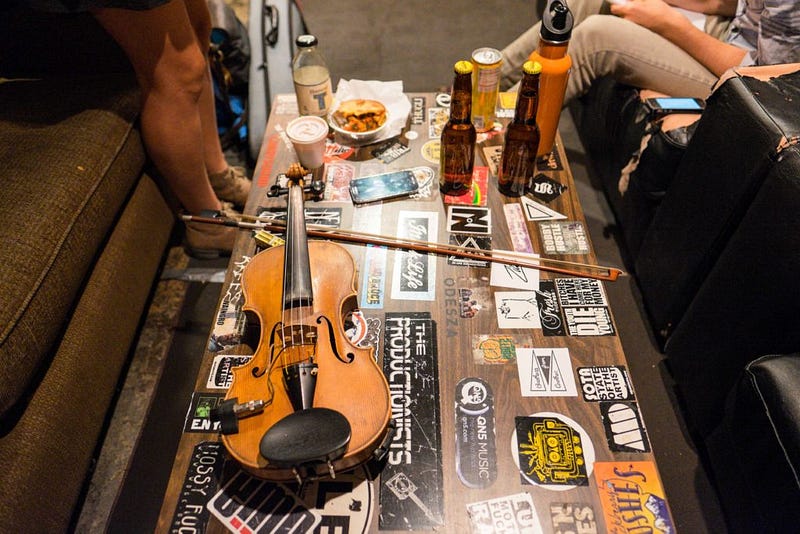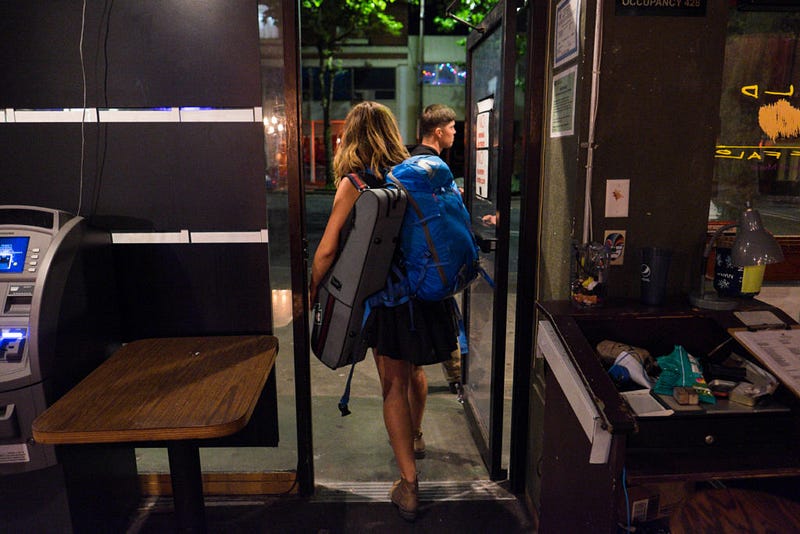Interrupted
Survivor of drugged driving accident struggles to find her place again
STORY BY ARIANA NAZARI | PHOTOS BY JAKE TULL
(Above) Chandra Johnson, who was involved in a devastating car crash in January 2015, practices violin along with songs she played from her phone in The Wild Buffalo’s green room. Besides the scar on her knee, one may never guess the many injuries she suffered in the crash.
She woke up in a dazed and confused state. Her body was aching. Chandra Johnson looked around the sterile, white hospital room trying to understand what had happened. Medical tubes weaved in and out of her body. Her family and boyfriend sat around her bed crying. They were all in disbelief that Chandra was even alive.
Chandra, 25, a Port Angeles native, had survived a car crash that turned her life inside out. Chandra’s right forearm was shattered, her right kneecap was shattered, her spleen had ruptured and one of her lungs had been punctured and collapsed. The tendons in her right hand were severed. Glass was embedded in her forehead.
“If there is anyone in this world who didn’t deserve this, it’s Chandra,” says Gus Johnson, 27, Chandra’s older brother. His sister is one of the most compassionate and generous people he knows. “And I’m not just saying that because she’s my sister,” he says. “It’s true.” The two siblings went to college together at Western. According to Gus, Chandra used to host huge breakfasts for friends on the weekend and cook her secret-recipe pancakes which she called “Chan-cakes.”
They grew up in a close-knit family of four. Living on the Olympic Peninsula fostered Chandra’s love of the outdoors. Mountaineering, playing violin, running and dancing are among some of the most sacred parts of her identity. The year of 2014 was proof of her determination to pursue her dreams.
In 2014, the talented 23-year-old Chandra had just graduated Western with a BA in music and a BS in environmental science. She spent time traveling in Nepal with her family and the year before that she went to the Peruvian Andes with the American Climber Science Program, a Colorado-based organization that works to explore and conserve isolated mountain regions. Throughout her time at Western, she played violin for the Seattle Rock Orchestra and several bluegrass, folk Bellingham-based bands, such as the Hot Damn Scandal, who she still plays with today. Chandra received the opportunity to play on the Jay Leno show during her time spent in the band of Grammy-nominated Seattle artist, Mary Lambert.

Chandra was also active in her pursuit of environmental science. She started working as an ecologist for Patagonia, collaborating with the clothing brand to remove four dams from the lower Snake River in Idaho that were endangering the local salmon population. The team she worked with had plans to travel to Washington, D.C. in the beginning of 2015, where they would sit down with members of congress to discuss their work and the implications of the problem they were tackling. It was a thrilling time for Chandra. She was seeing her hard work pay off through one exciting opportunity after another.
But her momentum came to a halt on Jan. 7, 2015.
A Drive to Freshwater Bay
That grey-skied Wednesday morning, Chandra was driving west on Highway 101 near Port Angeles. She was on the way to her boss’ house in Freshwater Bay, which borders the Straights of Juan De Fuca on the northern coast of the Olympic Peninsula.
On the opposite side of the freeway, a woman named Rachelle Grasso was driving east in a Toyota pickup truck. Grasso was driving under the influence of heroin and methadone, as stated in a Washington State Patrol vehicular assault report.
Driving at a speed of 100 mph, the Toyota crossed the highway median heading straight into Chandra’s lane. Chandra veered on to the shoulder to avoid collision, but Grasso was too fast and smashed head-on into the Nissan Ultima that Chandra’s was driving. The impact was so intense that Chandra’s car was sent spinning around in a circular twirl. Grasso’s car was then launched up and over Chandra’s Nissan, where responding EMTs would soon pull her out of. Grasso’s truck was left cracked in half. The scene went silent after the two vehicles came to a screeching stop.
A male EMT with a square-shaped face and blue eyes pulled a delusional Chandra out of her dismantled Nissan. It was one of the only details she remembers about the crash. Chandra seemed to think she was unharmed by the crash and she attempted to walk with her shattered kneecap while coughing up blood. Another woman EMT strapped her to a gurney and told Chandra “Oh honey, this is no dream.” She was then transported to the ICU in Olympic Medical Center in Port Angeles.
The Issue at Hand
Chandra’s accident was one of many incidents caused by “drugged driving,” which is becoming an increasing issue. All states have laws that address impaired-driving but, unlike laws regarding drunken driving, laws specific to driving under the influence of drugs (DUID) are nuanced and vary by state. According to the Governors Highway Safety Association, only 19 states have zero-tolerance laws that prohibit the intake of any illegal substances while driving. Washington is one of those states. But even in states that have explicit drugged driving laws, it can be hard for law enforcement to differentiate consequences between drugged and drunken driving.
According to the 2013 National Survey on Drug Use and Health (NSDUH), an estimated 9.9 million people aged 12 or older reported driving under the influence of federally illegal drugs widening the scope of this issue. The National Highway Traffic Safety Administration’s (NHTSA’s) 2013–2014 National Roadside Survey found that more than 22 percent of drivers tested positive for illegal, prescription or over-the-counter drugs.
Unlike drunken driving, there is no effective roadside test to determine drivers’ drug blood levels. Drugged drivers often have alcohol as well as multiple drugs in their systems. This makes it difficult to determine what substance had the greatest effect. In these cases, the impaired driver is often only tested for alcohol levels. The nuances related to DUID laws affect individuals like Chandra who are dragged into drawn-out trials.
Grasso, the woman who hit Chandra, has not gone to jail for her actions. The trial has been pushed back to later this summer and the prosecution has been very slow. Chandra says she is frustrated with the legal system because of this experience. “It doesn’t seem like anything has been brought to justice,” she says.
The on-going trial is just one of the many burdens that has resulted from the accident. Along with a long list of critical injuries, which she is still recovering from, Chandra has inherited chronic pain and growing medical bills that she and her parents struggle to pay for. But more than that, Chandra now has to cope with was how debilitating her accident came to be.

The Road to Recovery
Chandra was released from the hospital five days from being admitted, Jan. 11th — it was her 24th birthday.
“I was really depressed during this time,” she says. The right side of her body was practically useless. Chandra has often told friends, family and reporters that she is doing fine to relieve the concern of those around her. Recovering has been anything but easy for her.
For the first three months after Chandra was released from the hospital, she could only leave her house in Port Angeles for two reasons: relentless medical appointments and voice lessons that her friend’s father offered to her as a gift. These voice lessons are what kept Chandra sane while she was unable to pursue music or any other physical activity.
During this time, Chandra was very reliant on the help of her family members, boyfriend and close friends.
“I couldn’t wash myself. I couldn’t cut my own food, because I could only use one hand,” she says. “And shoelaces! Oh my god, shoelaces were impossible!”
Aside from her parents, Chandra pinpoints her brother Gus as the individual that helped her the most during the first three months of her recovery. Gus was with Chandra every day. He drove her to every medical appointment she had, on average about seven appointments a week. He was patient with her, she says, he let her cry and wiped away her tears.
“She just needed someone to commiserate with and share her frustrations,” Gus says.
In April 2015 about four months after her surgery she was medically cleared to play violin and dance again. At first Chandra thought her recovery process would be brief. Her body seemed to be healing fast and well. Chandra was getting stronger every day.
But now, almost a year after her accident, she realizes that her body is nowhere near back to normal and it never may be. Her arm is still healing. She is in physical therapy and experiencing memory loss along with whiplash issues. She just had her 10th surgery; this time it was on her kneecap. The surgery will determine whether she can do activities like yoga, hiking or skiing. All of this has taken a physiological toll on Chandra.
Chandra has had a difficult time coping with the chronic pain and the ways which the accident has impacted her family, her physical abilities and her finances. But Chandra prefers to be viewed as the positive and strong individual that those closest to her know she is.

The incredibly difficult road to recovery taught Chandra to cherish everything that she has in her in life. She has learned the immense value of family, community and support. The Port Angeles community cooked meals for her during her recovery and she often got free pedicures from a local nail salon. “There are always people who will care for you, and there are always people who will be there to support you. No matter how desperate things can get,” she says.
The Pacific Northwest music scene also welcomed her back with welcome arms. Through serious physical therapy, she’s back to doing what she loves. “I am not as good as I used to be, but I have never felt so loved before in my life,” she says. Discovering her true support system was a bittersweet realization but an important one.
“I have so many reasons to be alive,” she says. Her accident has shed light on what is important to Chandra and endowed her with patience. She has learned how to tackle and overcome mental roadblocks head on. “This has made me a stronger musician,” she says. “I take the time to work on the difficult parts, to get better.” She plans on doing whatever it takes to get stronger and healthier, in order to continue spending time outdoors and playing music.
Chandra highlights the importance of appreciating what you have in life, especially in times of hardship. There isn’t a single day that passes when she doesn’t think about what her life would be life if the accident never happened. But Chandra Johnson is living proof that there is no dream, which cannot be achieved, and no obstacle, which cannot be overcome if you are willing to put you mind to it.
